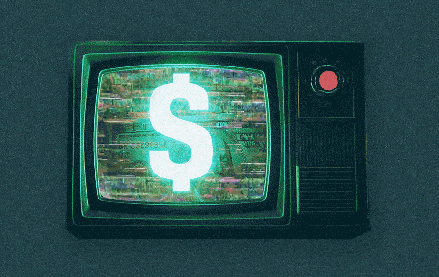Save 50% on a 3-month Digiday+ membership. Ends Dec 5.
Future of TV Briefing: A preview of Digiday’s CTV Advertising Strategies event

This Future of TV Briefing covers the latest in streaming and TV for Digiday+ members and is distributed over email every Wednesday at 10 a.m. ET. More from the series →
This week’s Future of TV Briefing previews next week’s CTV Advertising Strategies event that I’ll be hosting with top brand and agency executives in New York City.
- Must-CTV
- TikTok’s U.S.-only app, A+E Global Media’s for sale, Netflix’s Spotify collab, VTubers’ takeover and more
Must-CTV
The future of TV advertising will not be televised. It will be live — in New York City, next Tuesday.
Sorry to Gil Scott-Heron. Cringey cliches aside, on July 15 I’ll be joined by top executives from brands and agencies — including Amica Insurance, Danone, Dentsu, Horizon Media and UM Worldwide — at Digiday’s CTV Advertising Strategies event. And we will be spending the full day discussing the future of TV advertising by dissecting the current CTV ad market.
There will be sessions checking in on this year’s upfront market, assessing the streaming sports marketplace, gauging the value of CTV ads and nitpicking the programmatic supply chain. And of course we’ll have my favorite session of any Digiday event: the town hall, a closed-door discussion for attendees to air out their thoughts on the state of CTV advertising.
Whether you’re already planning to attend or debating whether to snatch up one of the last remaining slots, here’s a preview of the big questions we’ll be tackling throughout the day — though others will inevitably pop up on Tuesday. See you then.
Is the CTV ad market prepared for primetime?
Last year was a giant leap for the streaming ad market, with Amazon Prime Video’s entry, Peacock’s programmatic Olympic ad sales, Netflix’s Christmas Day NFL games, Walmart’s Vizio acquisition. Now to see how all that is landing with advertisers.
IPG Mediabrands’ Dani Benowitz will open the event with an overview of how streaming ad negotiations are going in this year’s annual TV and streaming upfront negotiations. That conversation will set the table for the rest of the day’s discussions by covering everything from the upfront model in an always-on marketplace, the role of programmatic buying and, of course, sports.
Horizon Media’s David Campanelli will take the baton on the latter topic, which has overtaken this year’s upfront with Amazon and Peacock pitching NBA games as well as YouTube and Netflix loading up on NFL games. But as ad tech aficionados acknowledged earlier this year, there’s still that question of whether the programmatic supply chain can handle this surplus of high-stakes live inventory. A corresponding question that I’ll be putting to Campanelli is to what extent advertisers are looking to take advantage of the addressable options, like dynamic ad insertion, that streaming offers for this inventory.
What’s the ROI on CTV?
CTV ad inventory is becoming more premium with the influx of major sports being streamed. But CTV ad prices also carry a premium, and that can be a problem for advertisers looking to strike the right balance between budget and benefit.
UM Worldwide’s Marcy Greenberger will outline the biggest challenges complicating advertisers’ abilities to maximize the returns they get for their dollars dedicated to CTV and what needs to happen to improve advertisers’ abilities to maximize ROI.
Wrangling reach and frequency is one improvement that would have an impact. To that end, Danone’s Kevin Manke will break down how the CPG brand has worked to consolidate its CTV buying into a single platform to avoid audience duplication and ad overexposures.
And speaking of ends, Amica Insurance’s Mike Plante will close the day by opening up the brand’s playbook for scrappy spending in CTV, a playbook that is still being written as Amica Insurance tries to crack the code on the right balance between CTV and traditional TV.
Why is CTV still a black box for advertisers?
You can’t talk about CTV advertising without talking about transparency. Trust me; it came up in just about every prep call I did with speakers ahead of next week’s event.
Much of that has to do with more and more ad dollars being spent on CTV inventory programmatically. Which is why Wpromote’s Skyler McGill will take stock of the demand-side platforms that advertisers are enlisting as the frontlines in their CTV ad buys as well as the tightening relationship between brands and agencies with supply-side platforms. Yes, terms like “log-level data” and “show-level reporting” will be bandied about.
If programmatic ad buying is on one end of the CTV black box, measurement is on the other. Seemingly measurement would shine a light on the issue – and it does – but even how CTV ads are measured needs to be more transparent. Why? How? I dunno – but Dentsu’s Celeste Castle does.
Are advertisers ready for the future of TV advertising?
The big question with a lot of sub-questions.
Are advertisers ready for non-traditional ad formats like pause ads and shoppable spots to become primary CTV ad products over traditional mid-rolls, and are those formats ready for that to happen? Walton Isaacson’s Albert Thompson will be tackling that one directly.
Are advertisers ready to adopt dynamic ad insertion for ads running in top-tier programming, like streaming live sports, and is there a limit on that implementation? We’ll cover that with Horizon Media’s Campanelli.
Can CTV live up to its promise to combine the unmatched upper-funnel faculties of traditional TV with the unparalleled precision of digital? Amica Insurance’s Plante and Dentsu’s Castle will be weighing in on this one from different angles. Plante from the perspective of a challenger brand looking to squeeze as much value out of its budget as possible. Castle through the lens of TV’s overall and overdue measurement overhaul.
But honestly, this question will come up across virtually every session. And I can’t wait to hear what everyone has to say.
What we’ve heard
“We had a crew of over 40 people. We had an aerial team. We had a helicopter with a Cineflex [camera system] flying around the plane. A group of stunt professionals who have worked on everything from Marvel to Avatar, where they’re overseeing all the logistics.”
— YouTube star Michelle Khare on the latest Digiday Podcast episode
Numbers to know
36%: Percentage share of American adults who watch traditional TV, compared to 83% who watch at least one streaming service.
$16 million: How much money Paramount agreed to pay President Donald Trump’s foundation to settle the leader of the free world’s lawsuit over how a “60 Minutes” interview with former Vice President Kamala Harris was edited.
$3.4 million: How much Fubo will pay to settle a class-action lawsuit over privacy violations.
33%: Percentage of survey respondents who cited Samsung as the brand behind their most-used TV set.
What we’ve covered
Michelle Khare on building Emmy-worthy content — one challenge at a time:
- The YouTube creator joined the Digiday Podcast to go behind the scenes of her videos’ production process.
- She recently recreated Tom Cruise’s plane stunt from “Mission: Impossible” for her series “Challenge Accepted.”
Listen to the latest Digiday Podcast episode here.
The upfront isn’t moving along for a few surprising reasons:
- The complexity of upfront deals and deal considerations is one factor putting the brakes on the annual haggle.
- Discrepancies with Nielsen’s shift to big data plus panel is another decelerant.
Read more about the upfront market here.
Best Buy, Lowe’s chief marketing officers explain why they launched new influencer programs:
- Best Buy launched its influencer program in April, and Lowe’s followed in June.
- The programs have creators host virtual storefronts in exchange for a commission on sales.
Read more about the retailers’ influencer marketing programs here.
Substack’s video bet could be a growth hack for small creators:
- Video is helping some Substack creators grow their followings, but more so for creators with fewer than 5,000 subscribers.
- Substack gives creators a full list of their subscribers, including open rates and subscription history.
Read more about Substack’s video push here.
What we’re reading
Just in time for ByteDance’s latest deadline to divest TikTok or let it be shut down in the U.S., the company is developing a U.S.-only version of the social video platform, according to The Information.
Disney and Hearst are looking into selling their ownership stakes in A+E Global Media at a time when Comcast and Warner Bros. Discovery have spun or are spinning off their cable TV networks, according to Variety.
The predominant video and audio streaming services are talking about teaming up on live music events, like an awards show or concert series, to air on Netflix, according to The Wall Street Journal.
Generative AI technology is making it easier for people to create virtual avatars to serve as the faces of YouTube channels, though some are using the tech to create “faceless” channels that can publish tens of videos per day and sound like the YouTube version of “made-for-advertising” sites, accrding to CNBC.
Investors are putting money into startups that aim to either provide AI tools to those producing movies and TV shows or that use AI technologies to create their own content, according to Business Insider.
Crunchyroll’s AI-generated captions controversy:
The anime-oriented streaming service served error-prone subtitles that were written by generative AI tools and blamed a third-party vendor for the issue, according to Engadget.
Want to discuss this with our editors and members? Join here, or log in if you're already a member.
More in Future of TV

Future of TV Briefing: The streaming ad upfront trends, programmatic priorities revealed in Q3 2025 earnings reports
This week’s Future of TV Briefing looks at what TV and streaming companies’ latest quarterly earnings report indicate about the state of the streaming ad market.

Future of TV Briefing: The creator economy needs a new currency for brand deals
This week’s Future of TV Briefing looks at why paying creators based on reach misses the mark and what IAB is doing to clear up the creator-brand currency situation.

Future of TV Briefing: WTF is IAB Tech Lab’s device attestation tactic to combat CTV ad fraud?
This week’s Future of TV Briefing breaks down the CTV ad industry’s new tool for fighting device spoofing.







